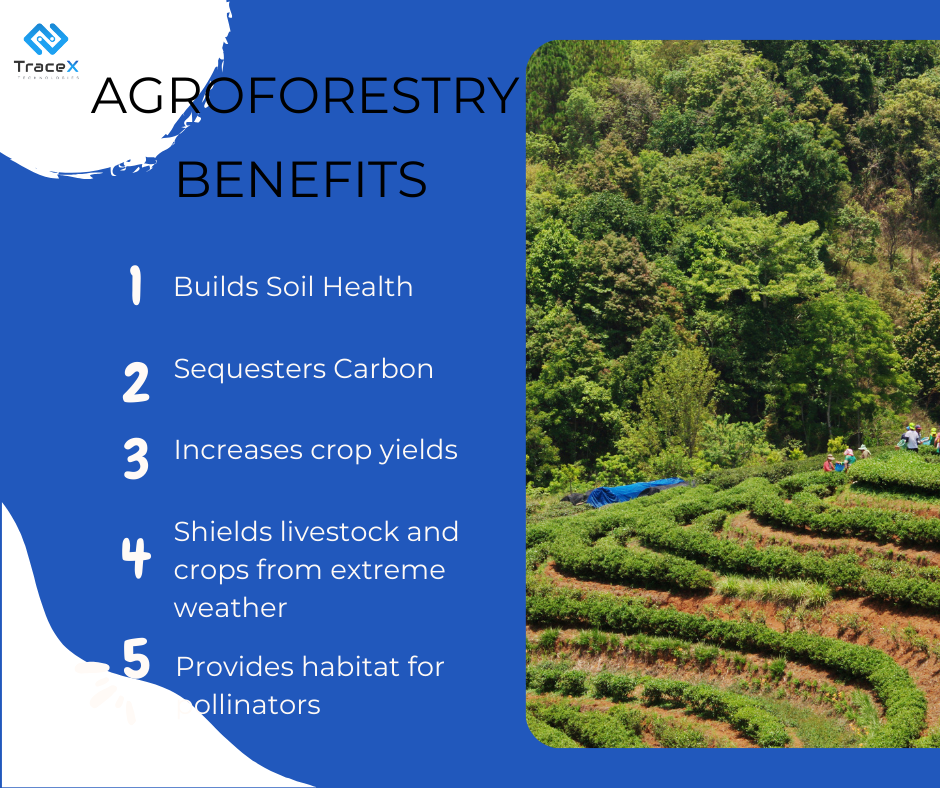Contact: +91 99725 24322 |
Menu
Menu
Quick summary: Dive into the transformative world of agroforestry within commodity supply chains. Explore the harmonious integration of trees and crops, unlocking sustainable practices in rubber, coffee, and cocoa production. Discover how this innovative approach not only enriches the agricultural landscape but also fosters biodiversity, resilience, and responsible resource management.

Are you struggling to make your supply chains more resilient and eco-friendlier?
In the face of escalating climate change and environmental degradation, traditional commodity supply chains are under intense scrutiny. The need to balance productivity with environmental stewardship has never been more urgent. Agroforestry offers a promising solution, integrating trees and shrubs into agricultural landscapes to enhance sustainability. However, the adoption of agroforestry practices in commodity supply chains like cocoa, coffee, and rubber remains limited and fraught with challenges.
Agroforestry, a sustainable land-use system, is a practice that integrates trees and shrubs into traditional agricultural settings, fostering a harmonious relationship between crops and forested elements. Unlike conventional monoculture, agroforestry embraces a diverse and interconnected approach, strategically combining trees or woody perennials with crops or livestock. This intentional integration yields a range of ecological, economic, and social benefits. The trees contribute to improved soil health, water conservation, and enhanced biodiversity, while simultaneously providing additional income streams for farmers through the sustainable harvest of timber, fruits, or nuts. Agroforestry not only enriches the overall agroecosystem but also stands as a testament to sustainable land management, promoting resilience and longevity in agricultural practices.
The integration of agroforestry is reshaping commodity supply chains and laying the foundation for a greener, more sustainable agricultural future. Agroforestry is a sustainable land management approach integrating trees and shrubs with crops or livestock. This synergistic system enhances biodiversity, improves soil fertility, and provides ecosystem services. The importance of agroforestry lies in its multifaceted contributions to sustainable agriculture. It fosters environmental resilience, mitigates climate change impacts, and promotes biodiversity conservation. Additionally, agroforestry systems enhance resource use efficiency, offering economic benefits to farmers.
Commodity supply chains represent the sequences of processes involved in producing, processing, and distributing goods. Understanding these chains is vital for sustainable agriculture as it enables traceability, quality control, and ethical practices, ensuring that commodities reach consumers in an environmentally responsible and socially equitable manner. Integrating agroforestry into these supply chains further reinforces sustainability by addressing ecological and economic aspects of agricultural production.
According to FAO, Agroforestry can increase soil organic matter, soil nitrogen, and carbon, which can increase the resilience of agricultural soils.
Agroforestry plays a pivotal role in enhancing sustainability within the rubber, coffee, and cocoa supply chains. Agroforestry in rubber cultivation, integrating trees improves soil health, reduces erosion, and offers shade, promoting optimal rubber tree growth. For coffee and cocoa, agroforestry provides shade to delicate plants, fostering a microclimate conducive to their development. Additionally, diverse tree-crop interactions contribute to increased biodiversity, pest control, and enhanced pollination services. This not only improves overall yield but also ensures the resilience of these supply chains to environmental changes. The integration of agroforestry practices in these industries exemplifies a holistic approach, balancing economic productivity with environmental and social considerations.
The adoption of agroforestry practices in rubber, coffee, and cocoa supply chains represents a transformative approach to sustainable agriculture
Cocoa, the primary ingredient in chocolate, is grown predominantly in tropical regions such as West Africa, South America, and Southeast Asia. Cocoa trees thrive in specific climatic conditions, requiring high temperatures, ample rainfall, and minimal temperature fluctuations. However, climate change is disrupting these conditions, posing significant risks to cocoa production.
Coffee, one of the world’s most traded commodities, is highly sensitive to climate conditions. Coffee plants require consistent rainfall and moderate temperatures to produce high-quality beans. Climate change is altering these conditions, leading to potential disruptions in coffee supply chains.
Rubber, primarily grown in tropical regions like Southeast Asia, is another key commodity affected by climate change. Rubber trees require specific climatic conditions to produce latex, and deviations from these conditions can impact production.

Integrating agroforestry into commodity supply chains yields crucial environmental benefits.
Firstly, carbon sequestration occurs as trees in agroforestry systems capture and store carbon, mitigating climate change. This aids in offsetting greenhouse gas emissions associated with commodity production. Secondly, biodiversity conservation is promoted as the diverse tree-crop interactions create habitat niches. This fosters a more resilient ecosystem, supporting various plant and animal species.
By enhancing carbon sequestration and biodiversity, agroforestry not only contributes to environmental sustainability but also enhances the overall resilience of commodity supply chains.
Agroforestry’s integration into commodity supply chains brings forth significant social benefits.
Overall, the social advantages of agroforestry contribute to sustainable rural development by strengthening community bonds, improving livelihoods, and promoting shared responsibility for environmental stewardship.
TraceX DMRV Platform plays a pivotal role in revolutionizing the management of agroforestry projects within supply chains. With an emphasis on transparency and efficiency, TraceX enables real-time monitoring and verification of diverse elements in agroforestry, from tree planting initiatives to crop cultivation. This not only ensures compliance with sustainable practices but also enhances the overall resilience and productivity of agroforestry projects. By streamlining data collection, automating verification processes, and fostering traceability, TraceX empowers supply chain managers to orchestrate agroforestry initiatives seamlessly, thereby promoting environmental sustainability and responsible resource management within the agricultural landscape.
Explore our DMRV Platform
Emerging technologies in agroforestry are transforming sustainable land management. Remote sensing aids in monitoring tree growth and health, while precision agriculture optimizes resource use. Agroforestry is well-positioned to scale up in global supply chains given its adaptability and positive environmental impact. Companies embracing agroforestry can enhance supply chain resilience by mitigating climate risks and ensuring resource availability. Partnerships between technology firms and agribusinesses can further streamline implementation and monitoring. Recognizing the potential for improved yield, reduced environmental footprint, and enhanced socio-economic outcomes, the global adoption of agroforestry in supply chains holds promise for a more sustainable and resilient future in agriculture.
In conclusion, agroforestry stands as a transformative force within global supply chains, addressing environmental, social, and economic imperatives. By seamlessly integrating trees with traditional crops, agroforestry enhances sustainability, offering carbon sequestration, biodiversity conservation, and diversified income sources. Overcoming challenges through collaborative efforts among farmers, companies, and supportive government policies is essential for widespread adoption. The potential for scaling up agroforestry is reinforced by emerging technologies, allowing for precise monitoring and optimized resource use. As we navigate the complexities of modern agriculture, embracing agroforestry not only fosters resilient supply chains but also contributes to a more harmonious coexistence between human activities and the natural world, paving the way for a sustainable and inclusive agricultural future.
